Finding Eureka
Art as evidence: finding Eureka
Where was the Eureka Stockade? Help solve the mystery!
More than 160 years after the infamous Eureka uprising of December 3, 1854, many a person has puzzled over the exact location of where the Eureka Stockade was raised in Ballarat. With archaeology, imagery, objects, records and local myths and legends as clues, fresh evidence may help us pinpoint the site once and for all - is it where the memorial stands today at the highest point of the Eureka Stockade Gardens, or is it not?
The Museum of Australian Democracy at Eureka (M.A.D.E) is calling for the public's help to answer the question.
As a special exhibition for Eureka Day, 2017, M.A.D.E will have on display 10 pages from an 1850s' sketchbook depicting life on the goldfields, along with other key original Eureka-era artworks, on loan from the Art Gallery of Ballarat. These images provide visual markers including landscape topography and the built features of homes and businesses, which together, may give away the Stockade's actual location.
How to get involved
Between X and X, search digital reproductions of the sketches below, or pick up printed postcards featuring them from M.A.D.E, Art Gallery of Ballarat, Ballarat Library or the Visitor Information Centre and use them to find the Eureka site.
Each postcard contains instructions on how to share where you think the Stockade site is:
Step 1: Familiarise yourself with the sketches and other evidence sources on this webpage, as well as historic maps on FedUni Spatial.
Step 2: Compare the past with the present by walking around the Eureka area or exploring it digitally using Google StreetView.
Step 4: See where others think the Eureka Stockade is on FedUni Spatial.
Step 3: Identify where you think the Eureka site is or where any of the artworks were painted from on the FedUni Spatial mapping tool, by selecting the 'comment' tab and then 'add point'. You can also add photos and thoughts about your chosen location in the comment box.
Step 5: Stay tuned to hear about the most popularly pinned sites, which will be announced by X on X.
Assembling the evidence
Sketchbook images
Artist bears witness
Charles A Doudiet was a Swiss artist who witnessed the attack on the Eureka Stockade. He painted the watercolour below, titled Eureka Slaughter, following the event in 1854 (image courtesy of Art Gallery of Ballarat).
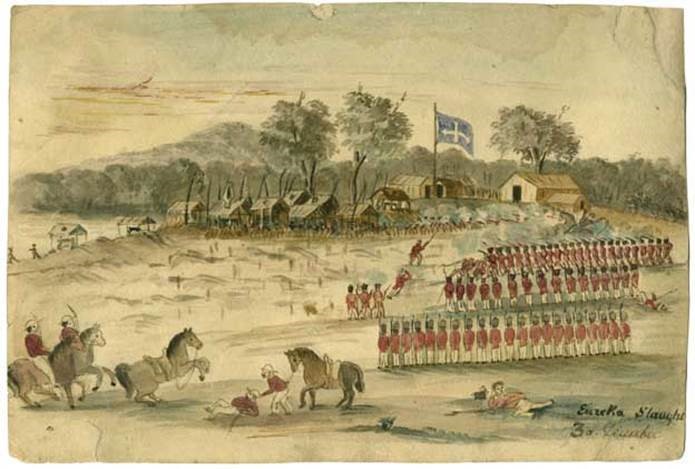
Where was Doudiet standing when he painted Eureka Slaughter?
Hints: The artwork shows Chinese on the left, Mount Warrenheip in the background and the sun is rising.
Doudiet also painted Swearing Allegiance to the Southern Cross in 1854, showing the rebels swearing allegiance to the flag prior to the Stockade (image courtesy of Art Gallery of Ballarat).
Where was Doudiet standing when he painted Swearing Allegiance to the Southern Cross?
Hints: Could the group of buildings and tents in the background, flying the British flag, be the Government Camp at today's Camp Street? Looking at Doudiet's other sketches, are there similar features at different angles that suggest artistic license?
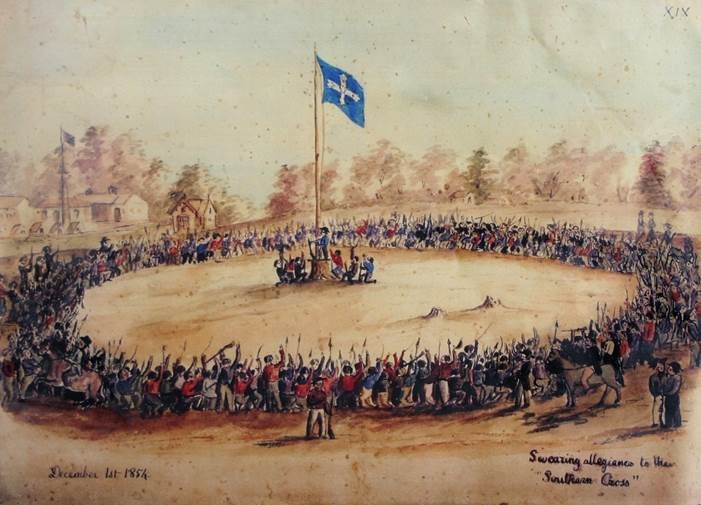
The Government Camp
Swiss-born Samuel Douglas Huyghue was the clerk of the Government Camp in 1854-5 and drew a plan of the attack on the Eureka Stockade, pictured below (image courtesy of Australian War Memorial).
Huyghue wrote a diary which was used for his reminiscences. He described the path taken by the troops on 3 December, 1854:
... at first curving well up under Black Hill and then striking a more direct course towards the rebel stronghold ... Pursuing their course now without further interruption they descended into a ravine and following up a shallow gully leading therefrom and separating the Free Trade Hotel from Stockyard Hill, arrived close to the hotel and within 200 yards of the enemy's position.
The stronghold was placed where the diggers had commences sinking ... The general lay of it was on a gentle slope leading up to and bordering the Melbourne Road, beyond which the ground fell away again more abruptly in an opposite direction, rugged with deserted working and studded with tents. The irregular enclosure comprised about an acre ...
Considering the sketches by both Doudiet and Huyghue, is there any reason to believe the Eureka Memorial is not the site of the Eureka Stockade?
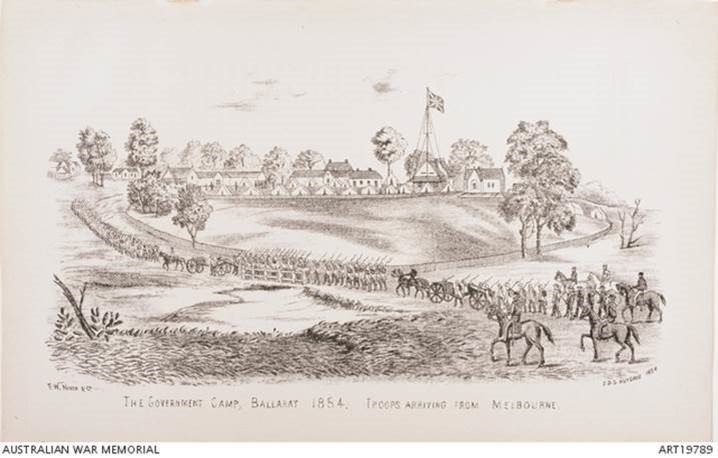
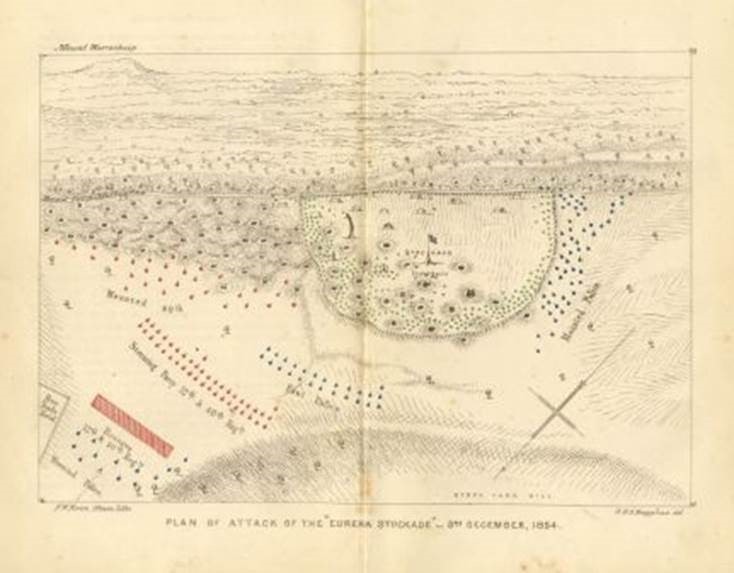
After the fact
Records show two very different views of the Eureka Stockade after the rebellion. Newspapers of the day reported a rapid return to calm, probably due to Martial Law being imposed. The lithograph below was printed in XX. Notice the planks of wood, a reference to the construction of the stockade.

Can you tell where this was? Would the trees really have been in neat rows?
Hint: Notice the Chinese camp on the left and Mount Warrenheip in the background.
One year after the storming of the Stockade, Huyghue visited the site on the edge of Ballarat and put his pen to paper. What he recorded here is the only topographically accurate view of the actual site of the stockade, from a time when everyone still knew exactly where it was located. Huyghue was a skilled draughtsman and the image is inscribed by him - ‘Huyghue December 1855 the site of the Eureka Stockade’. The drawing, shown below, is particularly interesting when compared with the diagram of the stockade that was used in the treason trials of the Stockaders early in 1855, which you can see on the grey wall next to the café at M.A.D.E.
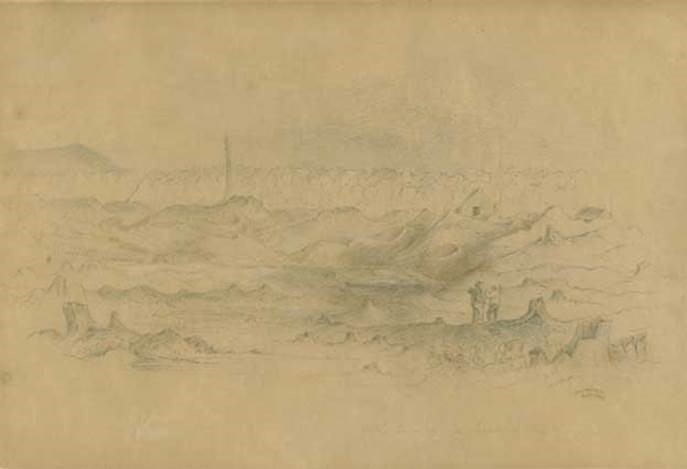





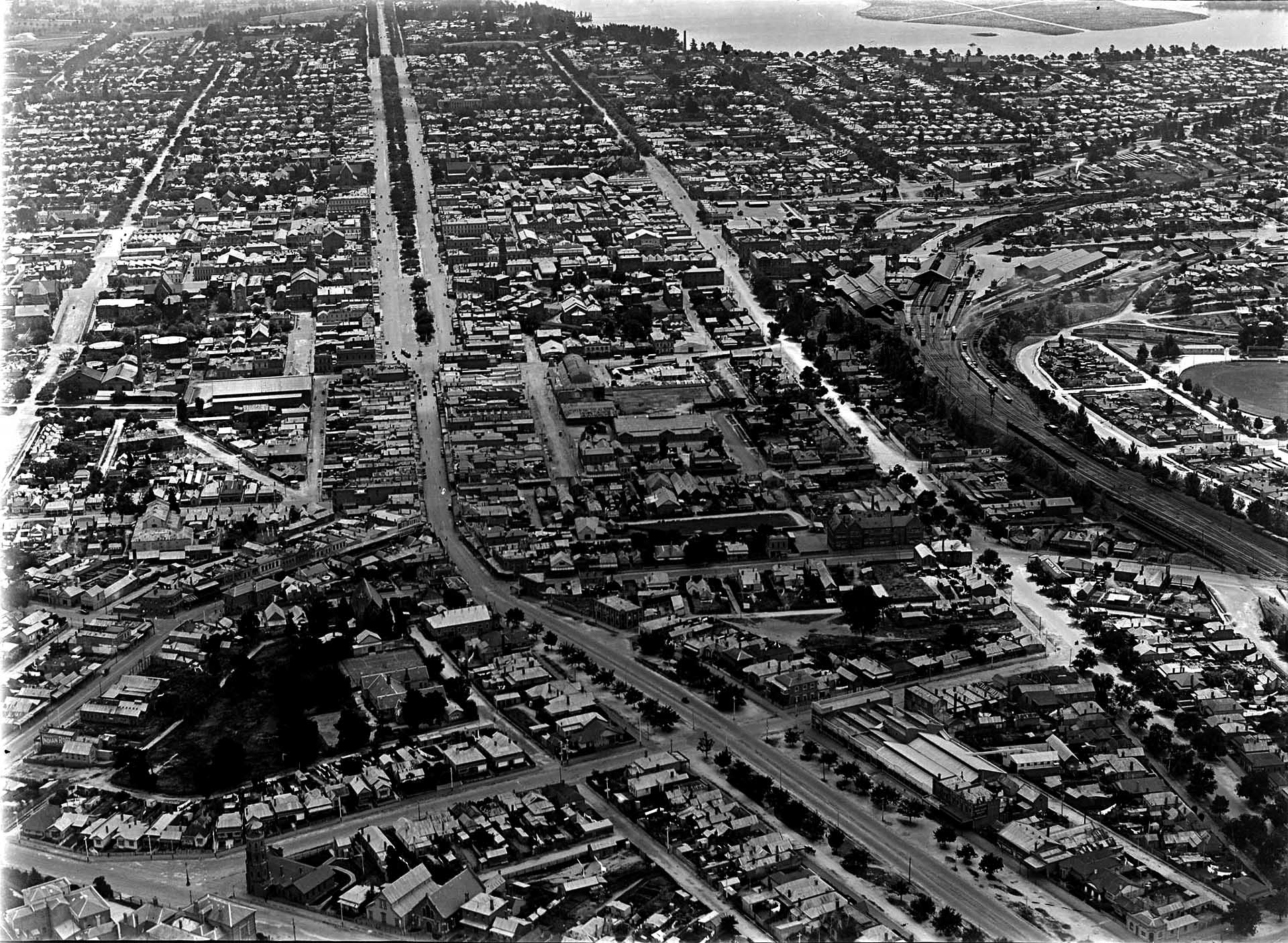

.jpg)